PPMP20009: Project Management Methodologies Report - Semester X
VerifiedAdded on 2019/11/20
|18
|3905
|177
Report
AI Summary
This report, focusing on project management methodologies, delves into the application and comparison of Agile, PMBoK, and PRINCE2 methodologies across various organizational contexts. The introduction highlights the importance of choosing the right methodology to achieve project objectives efficiently, reduce costs, and maintain quality. The main discussion analyzes the implementation process, emphasizing the roles of top management and team involvement. It outlines the stages of implementation, from maturity assessment to implementation, and underscores the importance of complete adoption of a methodology. The report then applies these methodologies to three distinct organizations: a financial services provider, a building society, and a technology services company, recommending the most suitable methodology for each based on factors like company size, structure, and operational complexity. The discussion also addresses potential implementation issues and the benefits of adopting the chosen methodologies. Finally, the conclusion summarizes the key findings and emphasizes the significance of selecting and implementing project management methodologies effectively.
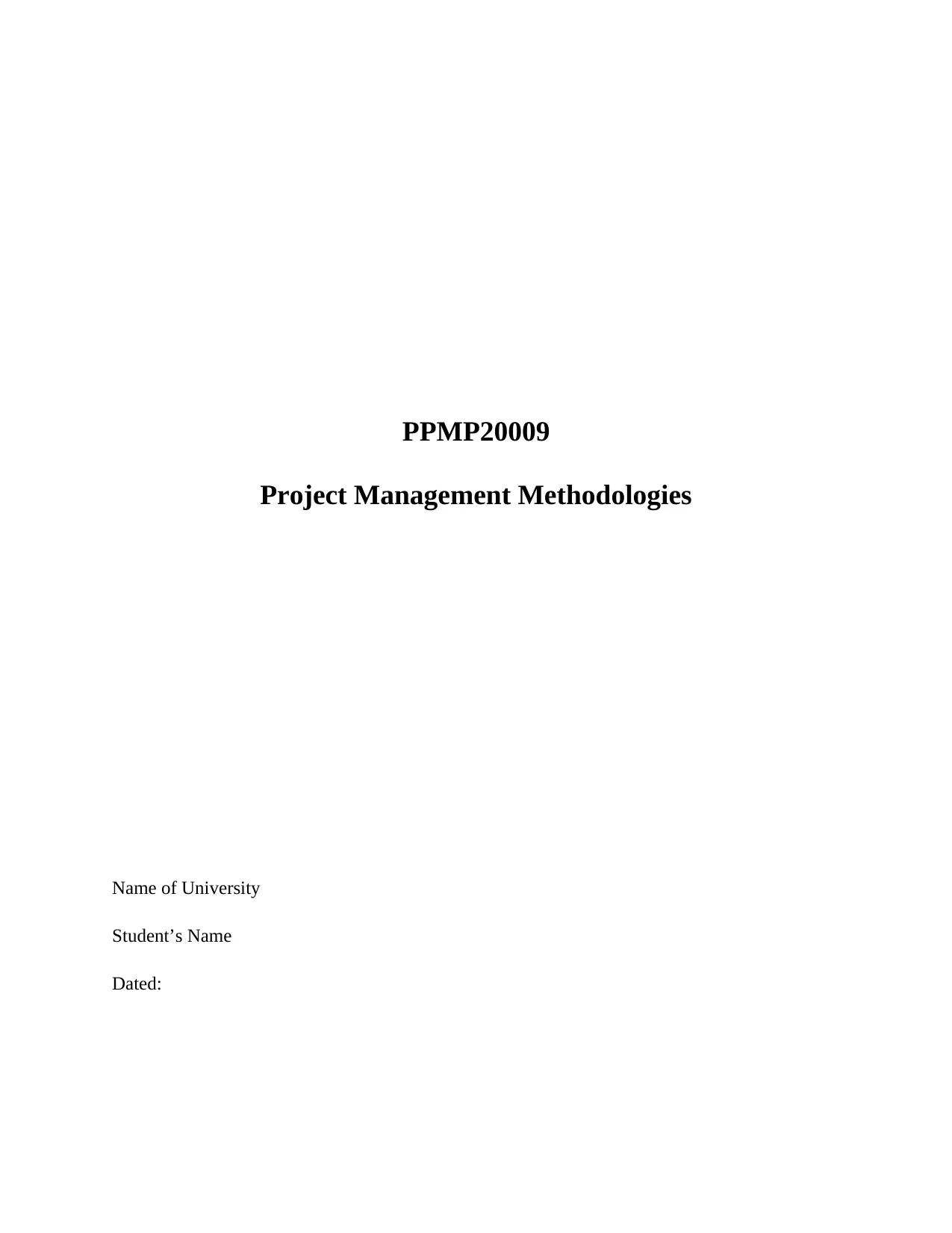
PPMP20009
Project Management Methodologies
Name of University
Student’s Name
Dated:
Project Management Methodologies
Name of University
Student’s Name
Dated:
Paraphrase This Document
Need a fresh take? Get an instant paraphrase of this document with our AI Paraphraser
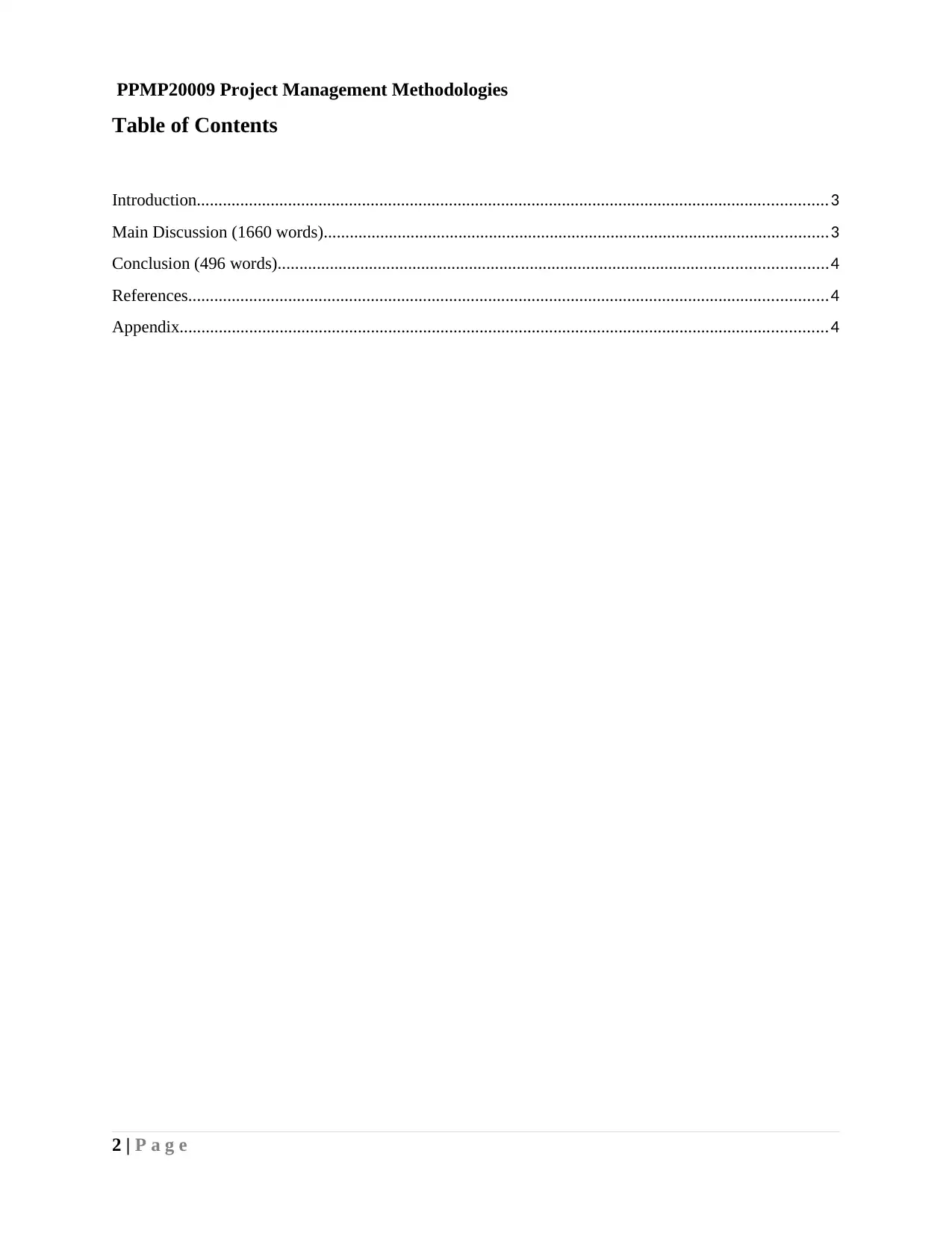
PPMP20009 Project Management Methodologies
Table of Contents
Introduction.................................................................................................................................................3
Main Discussion (1660 words)....................................................................................................................3
Conclusion (496 words)..............................................................................................................................4
References...................................................................................................................................................4
Appendix.....................................................................................................................................................4
2 | P a g e
Table of Contents
Introduction.................................................................................................................................................3
Main Discussion (1660 words)....................................................................................................................3
Conclusion (496 words)..............................................................................................................................4
References...................................................................................................................................................4
Appendix.....................................................................................................................................................4
2 | P a g e
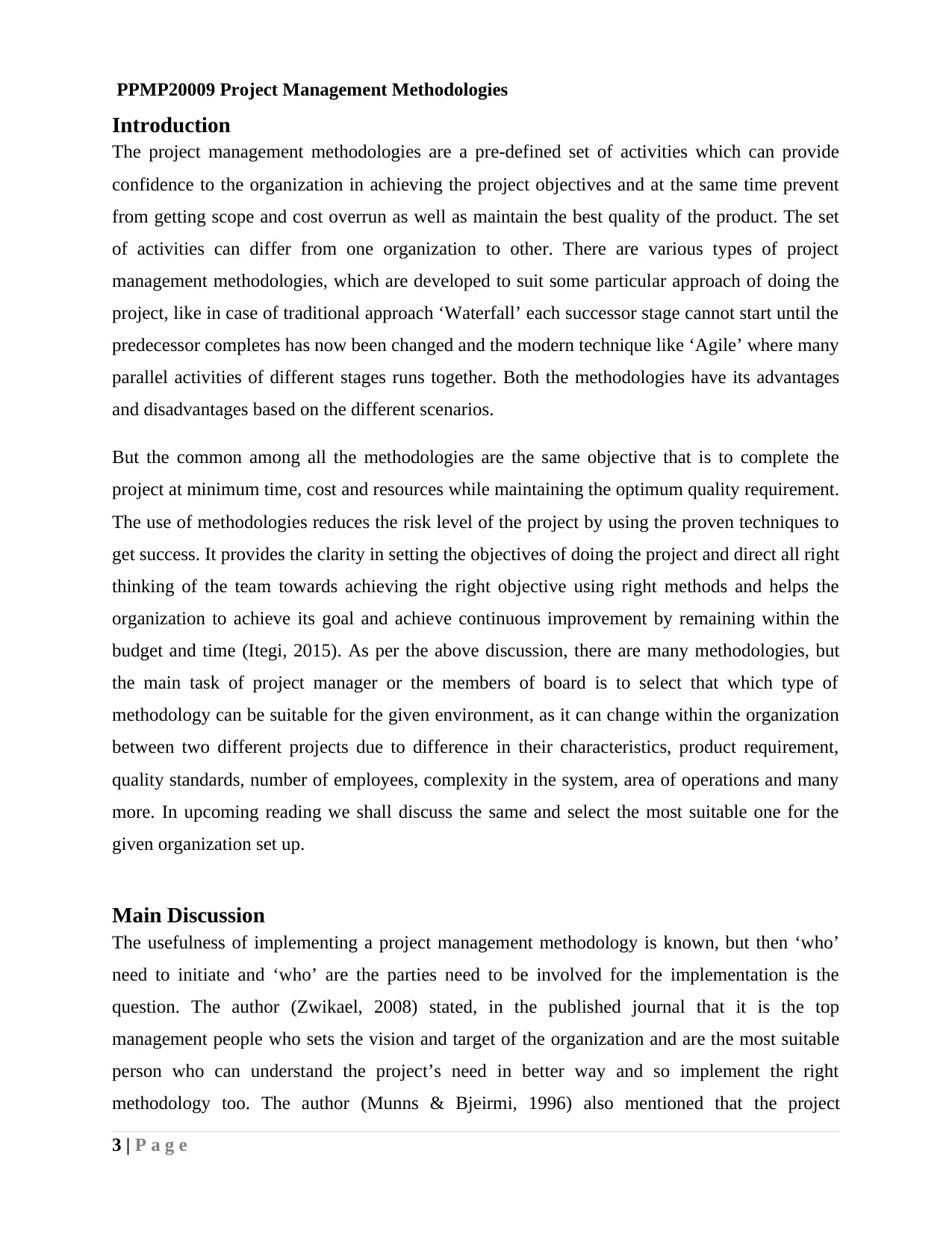
PPMP20009 Project Management Methodologies
Introduction
The project management methodologies are a pre-defined set of activities which can provide
confidence to the organization in achieving the project objectives and at the same time prevent
from getting scope and cost overrun as well as maintain the best quality of the product. The set
of activities can differ from one organization to other. There are various types of project
management methodologies, which are developed to suit some particular approach of doing the
project, like in case of traditional approach ‘Waterfall’ each successor stage cannot start until the
predecessor completes has now been changed and the modern technique like ‘Agile’ where many
parallel activities of different stages runs together. Both the methodologies have its advantages
and disadvantages based on the different scenarios.
But the common among all the methodologies are the same objective that is to complete the
project at minimum time, cost and resources while maintaining the optimum quality requirement.
The use of methodologies reduces the risk level of the project by using the proven techniques to
get success. It provides the clarity in setting the objectives of doing the project and direct all right
thinking of the team towards achieving the right objective using right methods and helps the
organization to achieve its goal and achieve continuous improvement by remaining within the
budget and time (Itegi, 2015). As per the above discussion, there are many methodologies, but
the main task of project manager or the members of board is to select that which type of
methodology can be suitable for the given environment, as it can change within the organization
between two different projects due to difference in their characteristics, product requirement,
quality standards, number of employees, complexity in the system, area of operations and many
more. In upcoming reading we shall discuss the same and select the most suitable one for the
given organization set up.
Main Discussion
The usefulness of implementing a project management methodology is known, but then ‘who’
need to initiate and ‘who’ are the parties need to be involved for the implementation is the
question. The author (Zwikael, 2008) stated, in the published journal that it is the top
management people who sets the vision and target of the organization and are the most suitable
person who can understand the project’s need in better way and so implement the right
methodology too. The author (Munns & Bjeirmi, 1996) also mentioned that the project
3 | P a g e
Introduction
The project management methodologies are a pre-defined set of activities which can provide
confidence to the organization in achieving the project objectives and at the same time prevent
from getting scope and cost overrun as well as maintain the best quality of the product. The set
of activities can differ from one organization to other. There are various types of project
management methodologies, which are developed to suit some particular approach of doing the
project, like in case of traditional approach ‘Waterfall’ each successor stage cannot start until the
predecessor completes has now been changed and the modern technique like ‘Agile’ where many
parallel activities of different stages runs together. Both the methodologies have its advantages
and disadvantages based on the different scenarios.
But the common among all the methodologies are the same objective that is to complete the
project at minimum time, cost and resources while maintaining the optimum quality requirement.
The use of methodologies reduces the risk level of the project by using the proven techniques to
get success. It provides the clarity in setting the objectives of doing the project and direct all right
thinking of the team towards achieving the right objective using right methods and helps the
organization to achieve its goal and achieve continuous improvement by remaining within the
budget and time (Itegi, 2015). As per the above discussion, there are many methodologies, but
the main task of project manager or the members of board is to select that which type of
methodology can be suitable for the given environment, as it can change within the organization
between two different projects due to difference in their characteristics, product requirement,
quality standards, number of employees, complexity in the system, area of operations and many
more. In upcoming reading we shall discuss the same and select the most suitable one for the
given organization set up.
Main Discussion
The usefulness of implementing a project management methodology is known, but then ‘who’
need to initiate and ‘who’ are the parties need to be involved for the implementation is the
question. The author (Zwikael, 2008) stated, in the published journal that it is the top
management people who sets the vision and target of the organization and are the most suitable
person who can understand the project’s need in better way and so implement the right
methodology too. The author (Munns & Bjeirmi, 1996) also mentioned that the project
3 | P a g e
⊘ This is a preview!⊘
Do you want full access?
Subscribe today to unlock all pages.

Trusted by 1+ million students worldwide
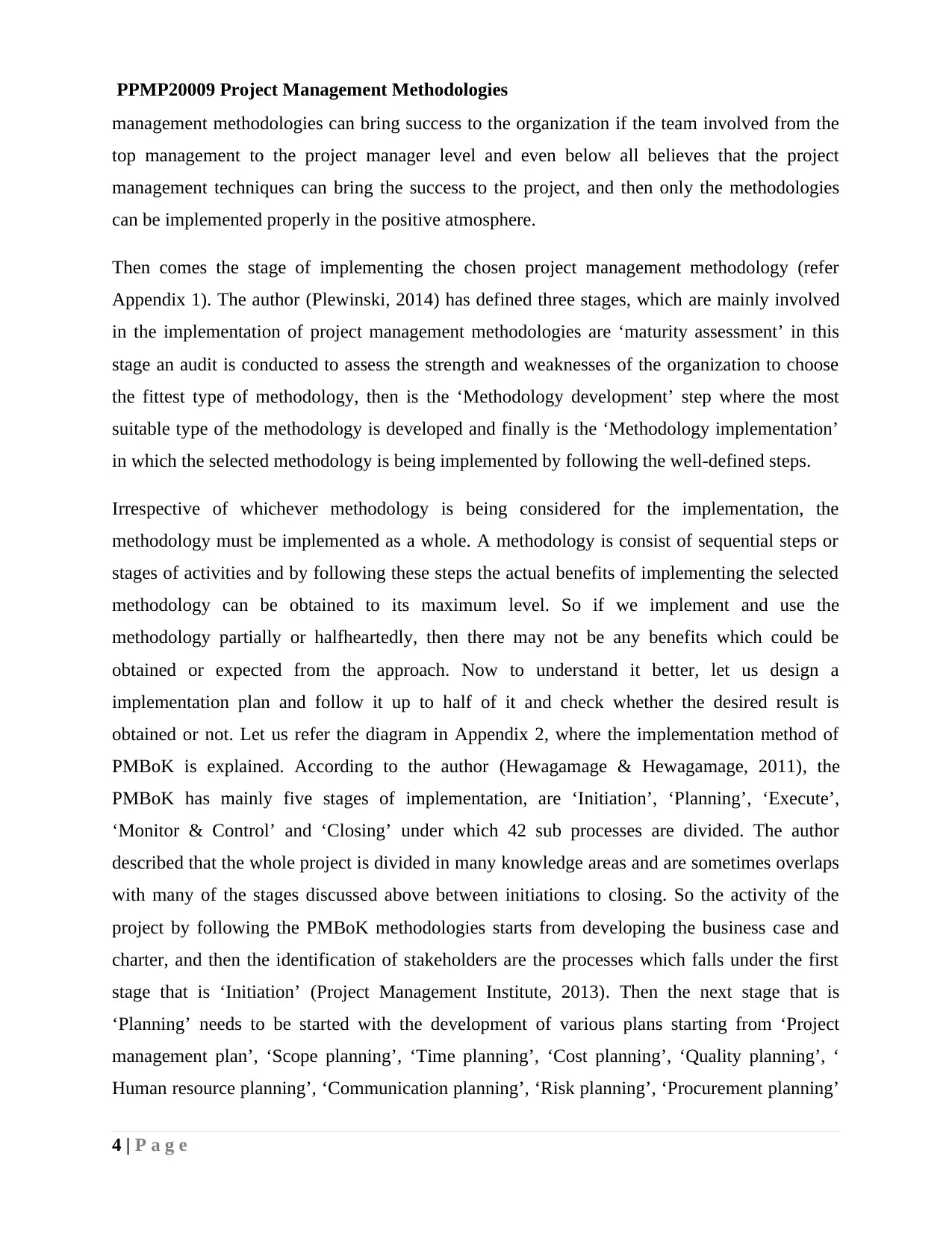
PPMP20009 Project Management Methodologies
management methodologies can bring success to the organization if the team involved from the
top management to the project manager level and even below all believes that the project
management techniques can bring the success to the project, and then only the methodologies
can be implemented properly in the positive atmosphere.
Then comes the stage of implementing the chosen project management methodology (refer
Appendix 1). The author (Plewinski, 2014) has defined three stages, which are mainly involved
in the implementation of project management methodologies are ‘maturity assessment’ in this
stage an audit is conducted to assess the strength and weaknesses of the organization to choose
the fittest type of methodology, then is the ‘Methodology development’ step where the most
suitable type of the methodology is developed and finally is the ‘Methodology implementation’
in which the selected methodology is being implemented by following the well-defined steps.
Irrespective of whichever methodology is being considered for the implementation, the
methodology must be implemented as a whole. A methodology is consist of sequential steps or
stages of activities and by following these steps the actual benefits of implementing the selected
methodology can be obtained to its maximum level. So if we implement and use the
methodology partially or halfheartedly, then there may not be any benefits which could be
obtained or expected from the approach. Now to understand it better, let us design a
implementation plan and follow it up to half of it and check whether the desired result is
obtained or not. Let us refer the diagram in Appendix 2, where the implementation method of
PMBoK is explained. According to the author (Hewagamage & Hewagamage, 2011), the
PMBoK has mainly five stages of implementation, are ‘Initiation’, ‘Planning’, ‘Execute’,
‘Monitor & Control’ and ‘Closing’ under which 42 sub processes are divided. The author
described that the whole project is divided in many knowledge areas and are sometimes overlaps
with many of the stages discussed above between initiations to closing. So the activity of the
project by following the PMBoK methodologies starts from developing the business case and
charter, and then the identification of stakeholders are the processes which falls under the first
stage that is ‘Initiation’ (Project Management Institute, 2013). Then the next stage that is
‘Planning’ needs to be started with the development of various plans starting from ‘Project
management plan’, ‘Scope planning’, ‘Time planning’, ‘Cost planning’, ‘Quality planning’, ‘
Human resource planning’, ‘Communication planning’, ‘Risk planning’, ‘Procurement planning’
4 | P a g e
management methodologies can bring success to the organization if the team involved from the
top management to the project manager level and even below all believes that the project
management techniques can bring the success to the project, and then only the methodologies
can be implemented properly in the positive atmosphere.
Then comes the stage of implementing the chosen project management methodology (refer
Appendix 1). The author (Plewinski, 2014) has defined three stages, which are mainly involved
in the implementation of project management methodologies are ‘maturity assessment’ in this
stage an audit is conducted to assess the strength and weaknesses of the organization to choose
the fittest type of methodology, then is the ‘Methodology development’ step where the most
suitable type of the methodology is developed and finally is the ‘Methodology implementation’
in which the selected methodology is being implemented by following the well-defined steps.
Irrespective of whichever methodology is being considered for the implementation, the
methodology must be implemented as a whole. A methodology is consist of sequential steps or
stages of activities and by following these steps the actual benefits of implementing the selected
methodology can be obtained to its maximum level. So if we implement and use the
methodology partially or halfheartedly, then there may not be any benefits which could be
obtained or expected from the approach. Now to understand it better, let us design a
implementation plan and follow it up to half of it and check whether the desired result is
obtained or not. Let us refer the diagram in Appendix 2, where the implementation method of
PMBoK is explained. According to the author (Hewagamage & Hewagamage, 2011), the
PMBoK has mainly five stages of implementation, are ‘Initiation’, ‘Planning’, ‘Execute’,
‘Monitor & Control’ and ‘Closing’ under which 42 sub processes are divided. The author
described that the whole project is divided in many knowledge areas and are sometimes overlaps
with many of the stages discussed above between initiations to closing. So the activity of the
project by following the PMBoK methodologies starts from developing the business case and
charter, and then the identification of stakeholders are the processes which falls under the first
stage that is ‘Initiation’ (Project Management Institute, 2013). Then the next stage that is
‘Planning’ needs to be started with the development of various plans starting from ‘Project
management plan’, ‘Scope planning’, ‘Time planning’, ‘Cost planning’, ‘Quality planning’, ‘
Human resource planning’, ‘Communication planning’, ‘Risk planning’, ‘Procurement planning’
4 | P a g e
Paraphrase This Document
Need a fresh take? Get an instant paraphrase of this document with our AI Paraphraser
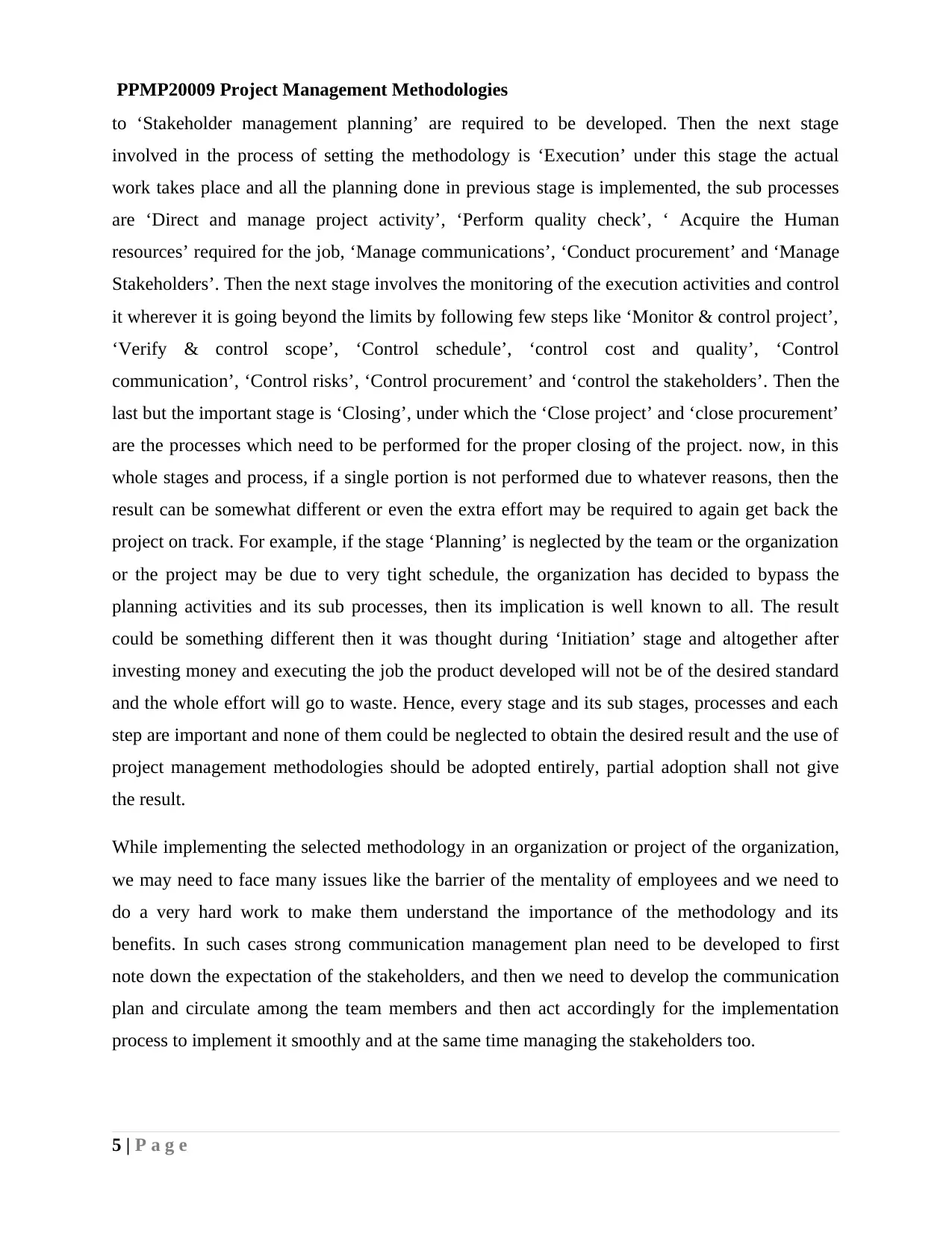
PPMP20009 Project Management Methodologies
to ‘Stakeholder management planning’ are required to be developed. Then the next stage
involved in the process of setting the methodology is ‘Execution’ under this stage the actual
work takes place and all the planning done in previous stage is implemented, the sub processes
are ‘Direct and manage project activity’, ‘Perform quality check’, ‘ Acquire the Human
resources’ required for the job, ‘Manage communications’, ‘Conduct procurement’ and ‘Manage
Stakeholders’. Then the next stage involves the monitoring of the execution activities and control
it wherever it is going beyond the limits by following few steps like ‘Monitor & control project’,
‘Verify & control scope’, ‘Control schedule’, ‘control cost and quality’, ‘Control
communication’, ‘Control risks’, ‘Control procurement’ and ‘control the stakeholders’. Then the
last but the important stage is ‘Closing’, under which the ‘Close project’ and ‘close procurement’
are the processes which need to be performed for the proper closing of the project. now, in this
whole stages and process, if a single portion is not performed due to whatever reasons, then the
result can be somewhat different or even the extra effort may be required to again get back the
project on track. For example, if the stage ‘Planning’ is neglected by the team or the organization
or the project may be due to very tight schedule, the organization has decided to bypass the
planning activities and its sub processes, then its implication is well known to all. The result
could be something different then it was thought during ‘Initiation’ stage and altogether after
investing money and executing the job the product developed will not be of the desired standard
and the whole effort will go to waste. Hence, every stage and its sub stages, processes and each
step are important and none of them could be neglected to obtain the desired result and the use of
project management methodologies should be adopted entirely, partial adoption shall not give
the result.
While implementing the selected methodology in an organization or project of the organization,
we may need to face many issues like the barrier of the mentality of employees and we need to
do a very hard work to make them understand the importance of the methodology and its
benefits. In such cases strong communication management plan need to be developed to first
note down the expectation of the stakeholders, and then we need to develop the communication
plan and circulate among the team members and then act accordingly for the implementation
process to implement it smoothly and at the same time managing the stakeholders too.
5 | P a g e
to ‘Stakeholder management planning’ are required to be developed. Then the next stage
involved in the process of setting the methodology is ‘Execution’ under this stage the actual
work takes place and all the planning done in previous stage is implemented, the sub processes
are ‘Direct and manage project activity’, ‘Perform quality check’, ‘ Acquire the Human
resources’ required for the job, ‘Manage communications’, ‘Conduct procurement’ and ‘Manage
Stakeholders’. Then the next stage involves the monitoring of the execution activities and control
it wherever it is going beyond the limits by following few steps like ‘Monitor & control project’,
‘Verify & control scope’, ‘Control schedule’, ‘control cost and quality’, ‘Control
communication’, ‘Control risks’, ‘Control procurement’ and ‘control the stakeholders’. Then the
last but the important stage is ‘Closing’, under which the ‘Close project’ and ‘close procurement’
are the processes which need to be performed for the proper closing of the project. now, in this
whole stages and process, if a single portion is not performed due to whatever reasons, then the
result can be somewhat different or even the extra effort may be required to again get back the
project on track. For example, if the stage ‘Planning’ is neglected by the team or the organization
or the project may be due to very tight schedule, the organization has decided to bypass the
planning activities and its sub processes, then its implication is well known to all. The result
could be something different then it was thought during ‘Initiation’ stage and altogether after
investing money and executing the job the product developed will not be of the desired standard
and the whole effort will go to waste. Hence, every stage and its sub stages, processes and each
step are important and none of them could be neglected to obtain the desired result and the use of
project management methodologies should be adopted entirely, partial adoption shall not give
the result.
While implementing the selected methodology in an organization or project of the organization,
we may need to face many issues like the barrier of the mentality of employees and we need to
do a very hard work to make them understand the importance of the methodology and its
benefits. In such cases strong communication management plan need to be developed to first
note down the expectation of the stakeholders, and then we need to develop the communication
plan and circulate among the team members and then act accordingly for the implementation
process to implement it smoothly and at the same time managing the stakeholders too.
5 | P a g e
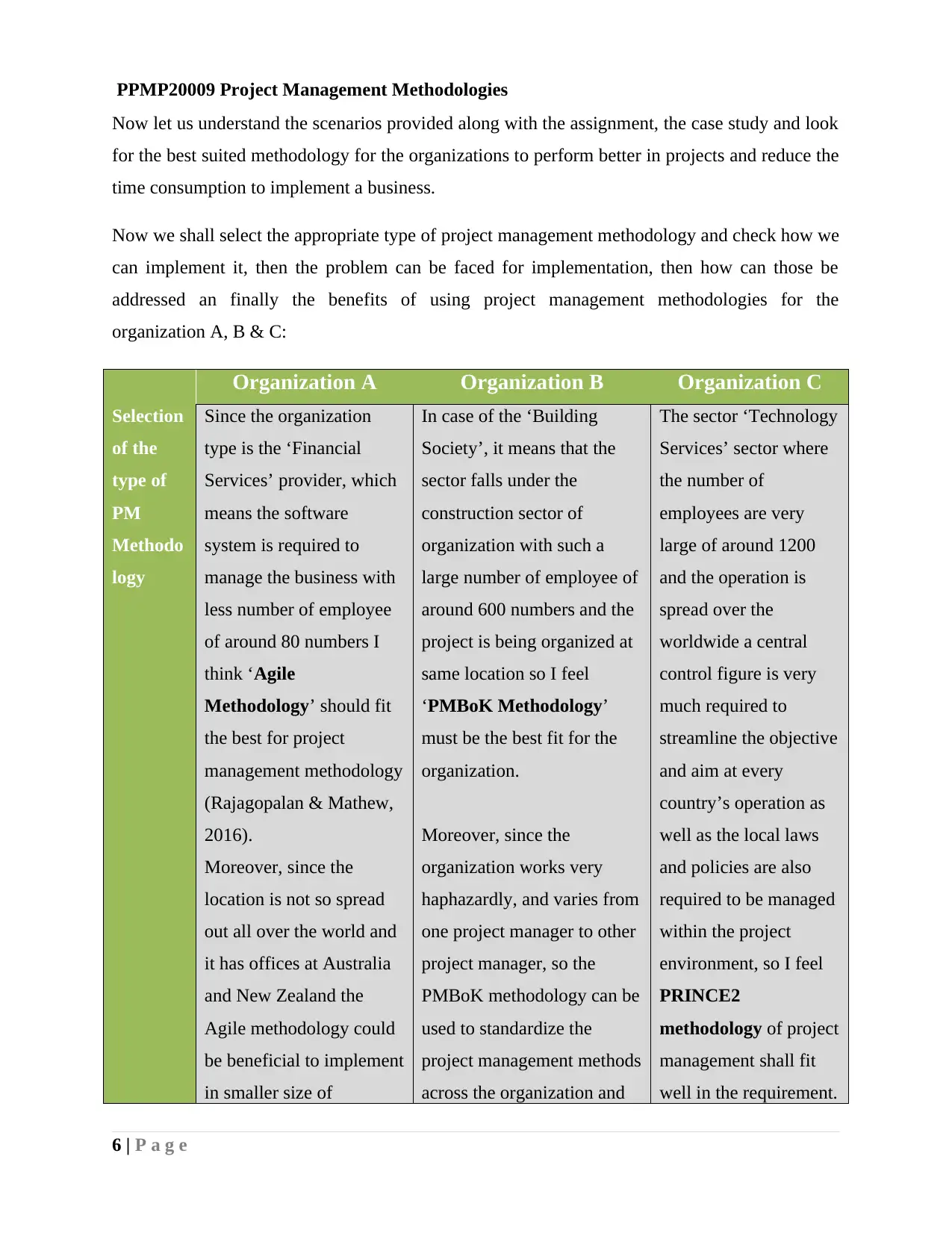
PPMP20009 Project Management Methodologies
Now let us understand the scenarios provided along with the assignment, the case study and look
for the best suited methodology for the organizations to perform better in projects and reduce the
time consumption to implement a business.
Now we shall select the appropriate type of project management methodology and check how we
can implement it, then the problem can be faced for implementation, then how can those be
addressed an finally the benefits of using project management methodologies for the
organization A, B & C:
Organization A Organization B Organization C
Selection
of the
type of
PM
Methodo
logy
Since the organization
type is the ‘Financial
Services’ provider, which
means the software
system is required to
manage the business with
less number of employee
of around 80 numbers I
think ‘Agile
Methodology’ should fit
the best for project
management methodology
(Rajagopalan & Mathew,
2016).
Moreover, since the
location is not so spread
out all over the world and
it has offices at Australia
and New Zealand the
Agile methodology could
be beneficial to implement
in smaller size of
In case of the ‘Building
Society’, it means that the
sector falls under the
construction sector of
organization with such a
large number of employee of
around 600 numbers and the
project is being organized at
same location so I feel
‘PMBoK Methodology’
must be the best fit for the
organization.
Moreover, since the
organization works very
haphazardly, and varies from
one project manager to other
project manager, so the
PMBoK methodology can be
used to standardize the
project management methods
across the organization and
The sector ‘Technology
Services’ sector where
the number of
employees are very
large of around 1200
and the operation is
spread over the
worldwide a central
control figure is very
much required to
streamline the objective
and aim at every
country’s operation as
well as the local laws
and policies are also
required to be managed
within the project
environment, so I feel
PRINCE2
methodology of project
management shall fit
well in the requirement.
6 | P a g e
Now let us understand the scenarios provided along with the assignment, the case study and look
for the best suited methodology for the organizations to perform better in projects and reduce the
time consumption to implement a business.
Now we shall select the appropriate type of project management methodology and check how we
can implement it, then the problem can be faced for implementation, then how can those be
addressed an finally the benefits of using project management methodologies for the
organization A, B & C:
Organization A Organization B Organization C
Selection
of the
type of
PM
Methodo
logy
Since the organization
type is the ‘Financial
Services’ provider, which
means the software
system is required to
manage the business with
less number of employee
of around 80 numbers I
think ‘Agile
Methodology’ should fit
the best for project
management methodology
(Rajagopalan & Mathew,
2016).
Moreover, since the
location is not so spread
out all over the world and
it has offices at Australia
and New Zealand the
Agile methodology could
be beneficial to implement
in smaller size of
In case of the ‘Building
Society’, it means that the
sector falls under the
construction sector of
organization with such a
large number of employee of
around 600 numbers and the
project is being organized at
same location so I feel
‘PMBoK Methodology’
must be the best fit for the
organization.
Moreover, since the
organization works very
haphazardly, and varies from
one project manager to other
project manager, so the
PMBoK methodology can be
used to standardize the
project management methods
across the organization and
The sector ‘Technology
Services’ sector where
the number of
employees are very
large of around 1200
and the operation is
spread over the
worldwide a central
control figure is very
much required to
streamline the objective
and aim at every
country’s operation as
well as the local laws
and policies are also
required to be managed
within the project
environment, so I feel
PRINCE2
methodology of project
management shall fit
well in the requirement.
6 | P a g e
⊘ This is a preview!⊘
Do you want full access?
Subscribe today to unlock all pages.

Trusted by 1+ million students worldwide
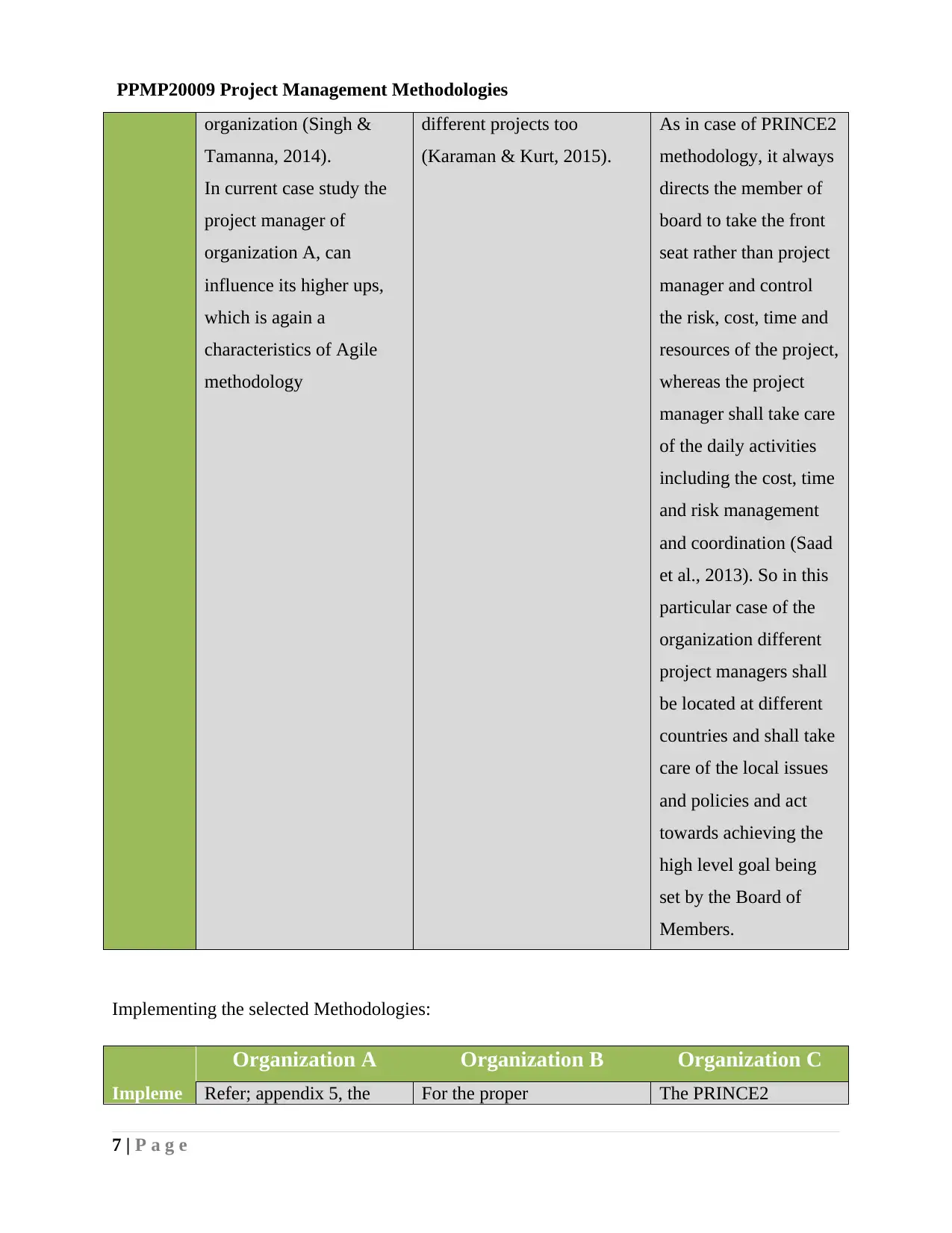
PPMP20009 Project Management Methodologies
organization (Singh &
Tamanna, 2014).
In current case study the
project manager of
organization A, can
influence its higher ups,
which is again a
characteristics of Agile
methodology
different projects too
(Karaman & Kurt, 2015).
As in case of PRINCE2
methodology, it always
directs the member of
board to take the front
seat rather than project
manager and control
the risk, cost, time and
resources of the project,
whereas the project
manager shall take care
of the daily activities
including the cost, time
and risk management
and coordination (Saad
et al., 2013). So in this
particular case of the
organization different
project managers shall
be located at different
countries and shall take
care of the local issues
and policies and act
towards achieving the
high level goal being
set by the Board of
Members.
Implementing the selected Methodologies:
Organization A Organization B Organization C
Impleme Refer; appendix 5, the For the proper The PRINCE2
7 | P a g e
organization (Singh &
Tamanna, 2014).
In current case study the
project manager of
organization A, can
influence its higher ups,
which is again a
characteristics of Agile
methodology
different projects too
(Karaman & Kurt, 2015).
As in case of PRINCE2
methodology, it always
directs the member of
board to take the front
seat rather than project
manager and control
the risk, cost, time and
resources of the project,
whereas the project
manager shall take care
of the daily activities
including the cost, time
and risk management
and coordination (Saad
et al., 2013). So in this
particular case of the
organization different
project managers shall
be located at different
countries and shall take
care of the local issues
and policies and act
towards achieving the
high level goal being
set by the Board of
Members.
Implementing the selected Methodologies:
Organization A Organization B Organization C
Impleme Refer; appendix 5, the For the proper The PRINCE2
7 | P a g e
Paraphrase This Document
Need a fresh take? Get an instant paraphrase of this document with our AI Paraphraser
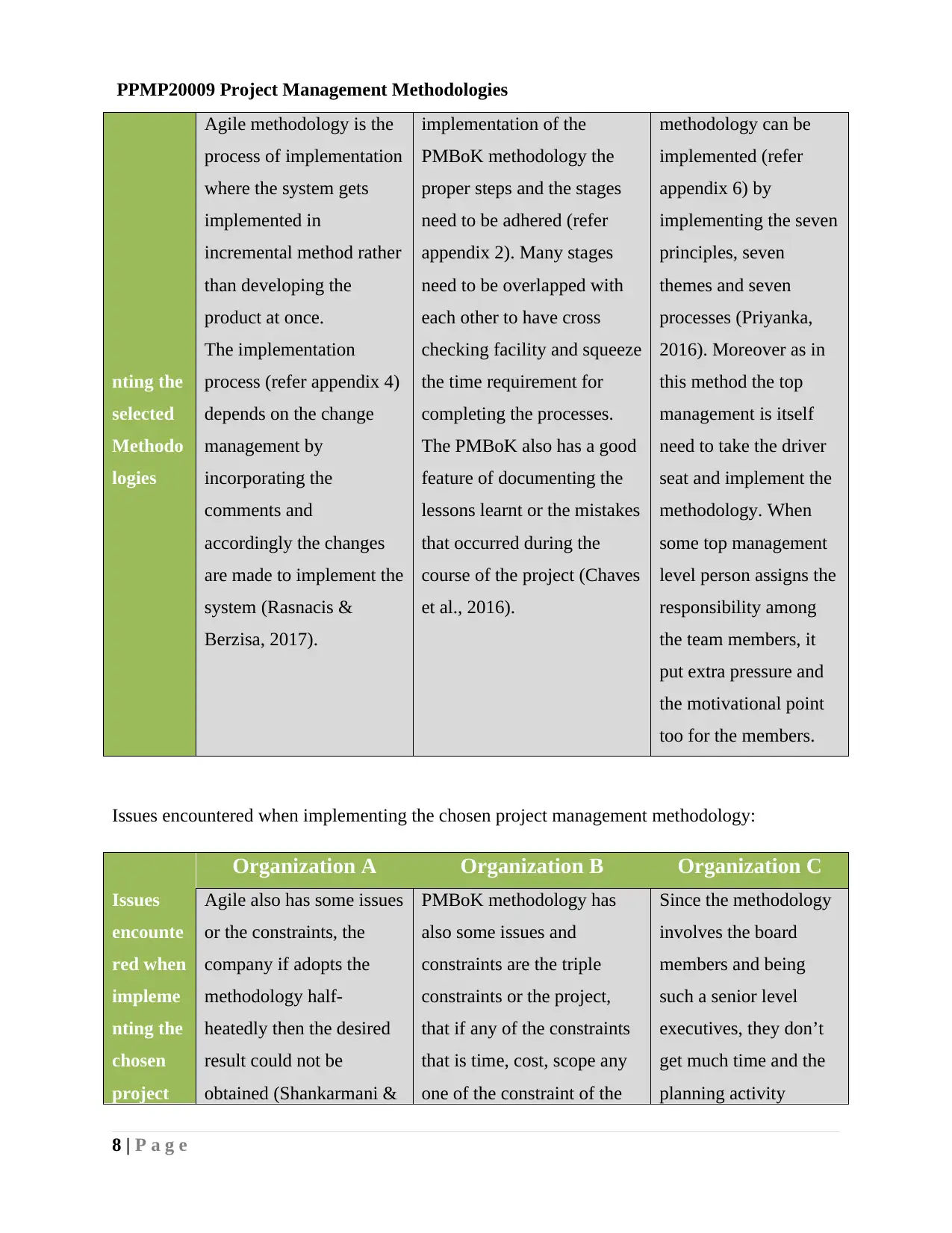
PPMP20009 Project Management Methodologies
nting the
selected
Methodo
logies
Agile methodology is the
process of implementation
where the system gets
implemented in
incremental method rather
than developing the
product at once.
The implementation
process (refer appendix 4)
depends on the change
management by
incorporating the
comments and
accordingly the changes
are made to implement the
system (Rasnacis &
Berzisa, 2017).
implementation of the
PMBoK methodology the
proper steps and the stages
need to be adhered (refer
appendix 2). Many stages
need to be overlapped with
each other to have cross
checking facility and squeeze
the time requirement for
completing the processes.
The PMBoK also has a good
feature of documenting the
lessons learnt or the mistakes
that occurred during the
course of the project (Chaves
et al., 2016).
methodology can be
implemented (refer
appendix 6) by
implementing the seven
principles, seven
themes and seven
processes (Priyanka,
2016). Moreover as in
this method the top
management is itself
need to take the driver
seat and implement the
methodology. When
some top management
level person assigns the
responsibility among
the team members, it
put extra pressure and
the motivational point
too for the members.
Issues encountered when implementing the chosen project management methodology:
Organization A Organization B Organization C
Issues
encounte
red when
impleme
nting the
chosen
project
Agile also has some issues
or the constraints, the
company if adopts the
methodology half-
heatedly then the desired
result could not be
obtained (Shankarmani &
PMBoK methodology has
also some issues and
constraints are the triple
constraints or the project,
that if any of the constraints
that is time, cost, scope any
one of the constraint of the
Since the methodology
involves the board
members and being
such a senior level
executives, they don’t
get much time and the
planning activity
8 | P a g e
nting the
selected
Methodo
logies
Agile methodology is the
process of implementation
where the system gets
implemented in
incremental method rather
than developing the
product at once.
The implementation
process (refer appendix 4)
depends on the change
management by
incorporating the
comments and
accordingly the changes
are made to implement the
system (Rasnacis &
Berzisa, 2017).
implementation of the
PMBoK methodology the
proper steps and the stages
need to be adhered (refer
appendix 2). Many stages
need to be overlapped with
each other to have cross
checking facility and squeeze
the time requirement for
completing the processes.
The PMBoK also has a good
feature of documenting the
lessons learnt or the mistakes
that occurred during the
course of the project (Chaves
et al., 2016).
methodology can be
implemented (refer
appendix 6) by
implementing the seven
principles, seven
themes and seven
processes (Priyanka,
2016). Moreover as in
this method the top
management is itself
need to take the driver
seat and implement the
methodology. When
some top management
level person assigns the
responsibility among
the team members, it
put extra pressure and
the motivational point
too for the members.
Issues encountered when implementing the chosen project management methodology:
Organization A Organization B Organization C
Issues
encounte
red when
impleme
nting the
chosen
project
Agile also has some issues
or the constraints, the
company if adopts the
methodology half-
heatedly then the desired
result could not be
obtained (Shankarmani &
PMBoK methodology has
also some issues and
constraints are the triple
constraints or the project,
that if any of the constraints
that is time, cost, scope any
one of the constraint of the
Since the methodology
involves the board
members and being
such a senior level
executives, they don’t
get much time and the
planning activity
8 | P a g e
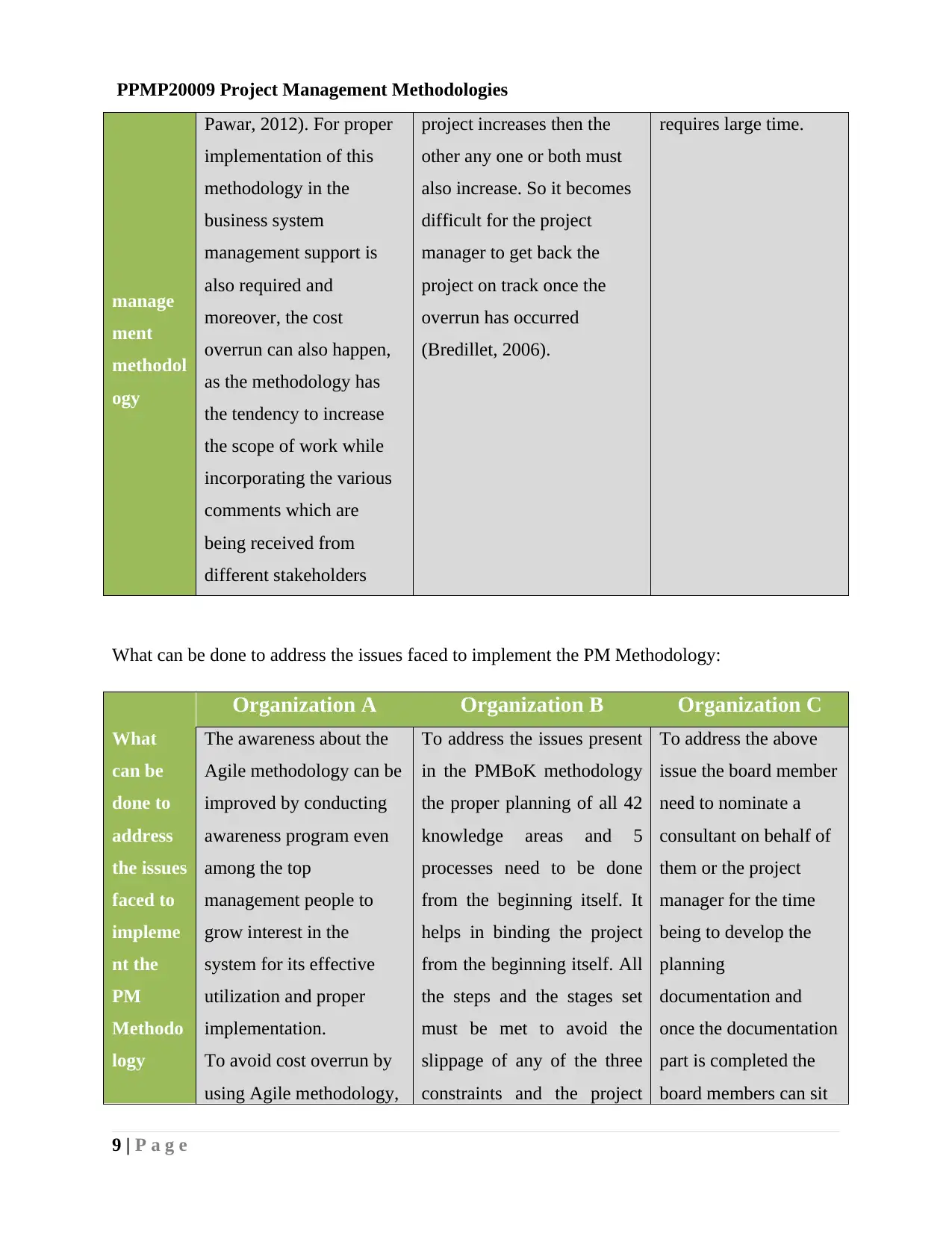
PPMP20009 Project Management Methodologies
manage
ment
methodol
ogy
Pawar, 2012). For proper
implementation of this
methodology in the
business system
management support is
also required and
moreover, the cost
overrun can also happen,
as the methodology has
the tendency to increase
the scope of work while
incorporating the various
comments which are
being received from
different stakeholders
project increases then the
other any one or both must
also increase. So it becomes
difficult for the project
manager to get back the
project on track once the
overrun has occurred
(Bredillet, 2006).
requires large time.
What can be done to address the issues faced to implement the PM Methodology:
Organization A Organization B Organization C
What
can be
done to
address
the issues
faced to
impleme
nt the
PM
Methodo
logy
The awareness about the
Agile methodology can be
improved by conducting
awareness program even
among the top
management people to
grow interest in the
system for its effective
utilization and proper
implementation.
To avoid cost overrun by
using Agile methodology,
To address the issues present
in the PMBoK methodology
the proper planning of all 42
knowledge areas and 5
processes need to be done
from the beginning itself. It
helps in binding the project
from the beginning itself. All
the steps and the stages set
must be met to avoid the
slippage of any of the three
constraints and the project
To address the above
issue the board member
need to nominate a
consultant on behalf of
them or the project
manager for the time
being to develop the
planning
documentation and
once the documentation
part is completed the
board members can sit
9 | P a g e
manage
ment
methodol
ogy
Pawar, 2012). For proper
implementation of this
methodology in the
business system
management support is
also required and
moreover, the cost
overrun can also happen,
as the methodology has
the tendency to increase
the scope of work while
incorporating the various
comments which are
being received from
different stakeholders
project increases then the
other any one or both must
also increase. So it becomes
difficult for the project
manager to get back the
project on track once the
overrun has occurred
(Bredillet, 2006).
requires large time.
What can be done to address the issues faced to implement the PM Methodology:
Organization A Organization B Organization C
What
can be
done to
address
the issues
faced to
impleme
nt the
PM
Methodo
logy
The awareness about the
Agile methodology can be
improved by conducting
awareness program even
among the top
management people to
grow interest in the
system for its effective
utilization and proper
implementation.
To avoid cost overrun by
using Agile methodology,
To address the issues present
in the PMBoK methodology
the proper planning of all 42
knowledge areas and 5
processes need to be done
from the beginning itself. It
helps in binding the project
from the beginning itself. All
the steps and the stages set
must be met to avoid the
slippage of any of the three
constraints and the project
To address the above
issue the board member
need to nominate a
consultant on behalf of
them or the project
manager for the time
being to develop the
planning
documentation and
once the documentation
part is completed the
board members can sit
9 | P a g e
⊘ This is a preview!⊘
Do you want full access?
Subscribe today to unlock all pages.

Trusted by 1+ million students worldwide
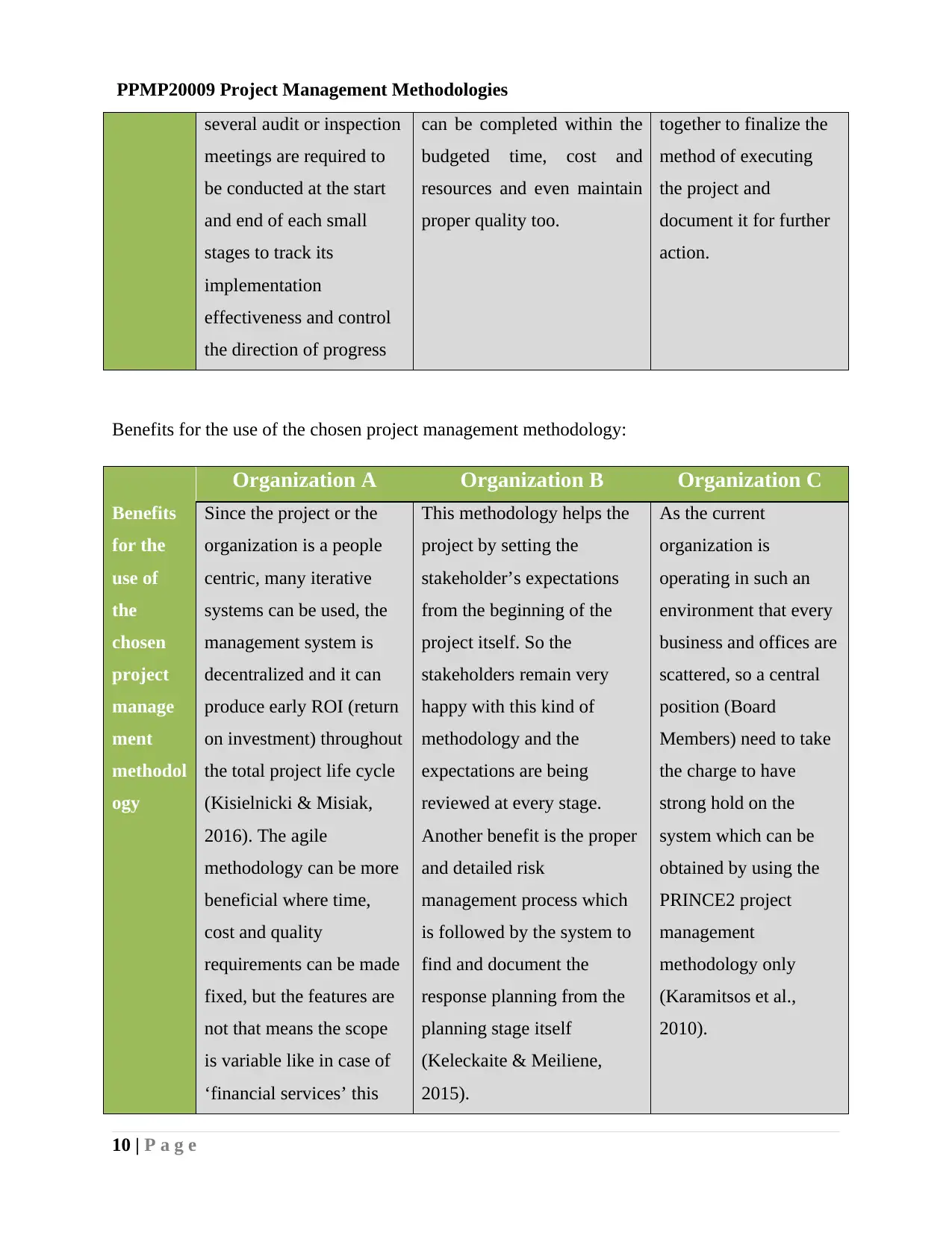
PPMP20009 Project Management Methodologies
several audit or inspection
meetings are required to
be conducted at the start
and end of each small
stages to track its
implementation
effectiveness and control
the direction of progress
can be completed within the
budgeted time, cost and
resources and even maintain
proper quality too.
together to finalize the
method of executing
the project and
document it for further
action.
Benefits for the use of the chosen project management methodology:
Organization A Organization B Organization C
Benefits
for the
use of
the
chosen
project
manage
ment
methodol
ogy
Since the project or the
organization is a people
centric, many iterative
systems can be used, the
management system is
decentralized and it can
produce early ROI (return
on investment) throughout
the total project life cycle
(Kisielnicki & Misiak,
2016). The agile
methodology can be more
beneficial where time,
cost and quality
requirements can be made
fixed, but the features are
not that means the scope
is variable like in case of
‘financial services’ this
This methodology helps the
project by setting the
stakeholder’s expectations
from the beginning of the
project itself. So the
stakeholders remain very
happy with this kind of
methodology and the
expectations are being
reviewed at every stage.
Another benefit is the proper
and detailed risk
management process which
is followed by the system to
find and document the
response planning from the
planning stage itself
(Keleckaite & Meiliene,
2015).
As the current
organization is
operating in such an
environment that every
business and offices are
scattered, so a central
position (Board
Members) need to take
the charge to have
strong hold on the
system which can be
obtained by using the
PRINCE2 project
management
methodology only
(Karamitsos et al.,
2010).
10 | P a g e
several audit or inspection
meetings are required to
be conducted at the start
and end of each small
stages to track its
implementation
effectiveness and control
the direction of progress
can be completed within the
budgeted time, cost and
resources and even maintain
proper quality too.
together to finalize the
method of executing
the project and
document it for further
action.
Benefits for the use of the chosen project management methodology:
Organization A Organization B Organization C
Benefits
for the
use of
the
chosen
project
manage
ment
methodol
ogy
Since the project or the
organization is a people
centric, many iterative
systems can be used, the
management system is
decentralized and it can
produce early ROI (return
on investment) throughout
the total project life cycle
(Kisielnicki & Misiak,
2016). The agile
methodology can be more
beneficial where time,
cost and quality
requirements can be made
fixed, but the features are
not that means the scope
is variable like in case of
‘financial services’ this
This methodology helps the
project by setting the
stakeholder’s expectations
from the beginning of the
project itself. So the
stakeholders remain very
happy with this kind of
methodology and the
expectations are being
reviewed at every stage.
Another benefit is the proper
and detailed risk
management process which
is followed by the system to
find and document the
response planning from the
planning stage itself
(Keleckaite & Meiliene,
2015).
As the current
organization is
operating in such an
environment that every
business and offices are
scattered, so a central
position (Board
Members) need to take
the charge to have
strong hold on the
system which can be
obtained by using the
PRINCE2 project
management
methodology only
(Karamitsos et al.,
2010).
10 | P a g e
Paraphrase This Document
Need a fresh take? Get an instant paraphrase of this document with our AI Paraphraser
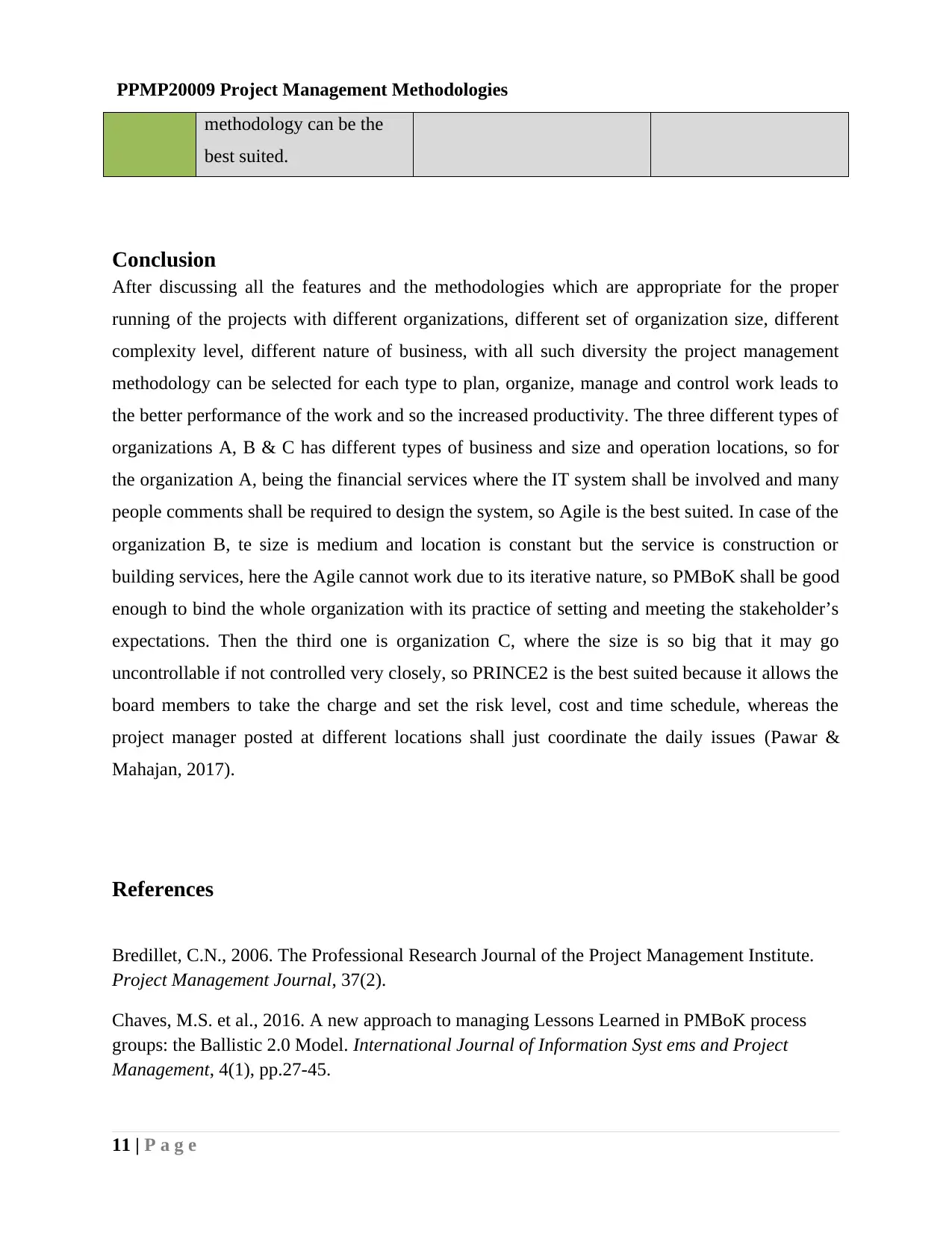
PPMP20009 Project Management Methodologies
methodology can be the
best suited.
Conclusion
After discussing all the features and the methodologies which are appropriate for the proper
running of the projects with different organizations, different set of organization size, different
complexity level, different nature of business, with all such diversity the project management
methodology can be selected for each type to plan, organize, manage and control work leads to
the better performance of the work and so the increased productivity. The three different types of
organizations A, B & C has different types of business and size and operation locations, so for
the organization A, being the financial services where the IT system shall be involved and many
people comments shall be required to design the system, so Agile is the best suited. In case of the
organization B, te size is medium and location is constant but the service is construction or
building services, here the Agile cannot work due to its iterative nature, so PMBoK shall be good
enough to bind the whole organization with its practice of setting and meeting the stakeholder’s
expectations. Then the third one is organization C, where the size is so big that it may go
uncontrollable if not controlled very closely, so PRINCE2 is the best suited because it allows the
board members to take the charge and set the risk level, cost and time schedule, whereas the
project manager posted at different locations shall just coordinate the daily issues (Pawar &
Mahajan, 2017).
References
Bredillet, C.N., 2006. The Professional Research Journal of the Project Management Institute.
Project Management Journal, 37(2).
Chaves, M.S. et al., 2016. A new approach to managing Lessons Learned in PMBoK process
groups: the Ballistic 2.0 Model. International Journal of Information Syst ems and Project
Management, 4(1), pp.27-45.
11 | P a g e
methodology can be the
best suited.
Conclusion
After discussing all the features and the methodologies which are appropriate for the proper
running of the projects with different organizations, different set of organization size, different
complexity level, different nature of business, with all such diversity the project management
methodology can be selected for each type to plan, organize, manage and control work leads to
the better performance of the work and so the increased productivity. The three different types of
organizations A, B & C has different types of business and size and operation locations, so for
the organization A, being the financial services where the IT system shall be involved and many
people comments shall be required to design the system, so Agile is the best suited. In case of the
organization B, te size is medium and location is constant but the service is construction or
building services, here the Agile cannot work due to its iterative nature, so PMBoK shall be good
enough to bind the whole organization with its practice of setting and meeting the stakeholder’s
expectations. Then the third one is organization C, where the size is so big that it may go
uncontrollable if not controlled very closely, so PRINCE2 is the best suited because it allows the
board members to take the charge and set the risk level, cost and time schedule, whereas the
project manager posted at different locations shall just coordinate the daily issues (Pawar &
Mahajan, 2017).
References
Bredillet, C.N., 2006. The Professional Research Journal of the Project Management Institute.
Project Management Journal, 37(2).
Chaves, M.S. et al., 2016. A new approach to managing Lessons Learned in PMBoK process
groups: the Ballistic 2.0 Model. International Journal of Information Syst ems and Project
Management, 4(1), pp.27-45.
11 | P a g e
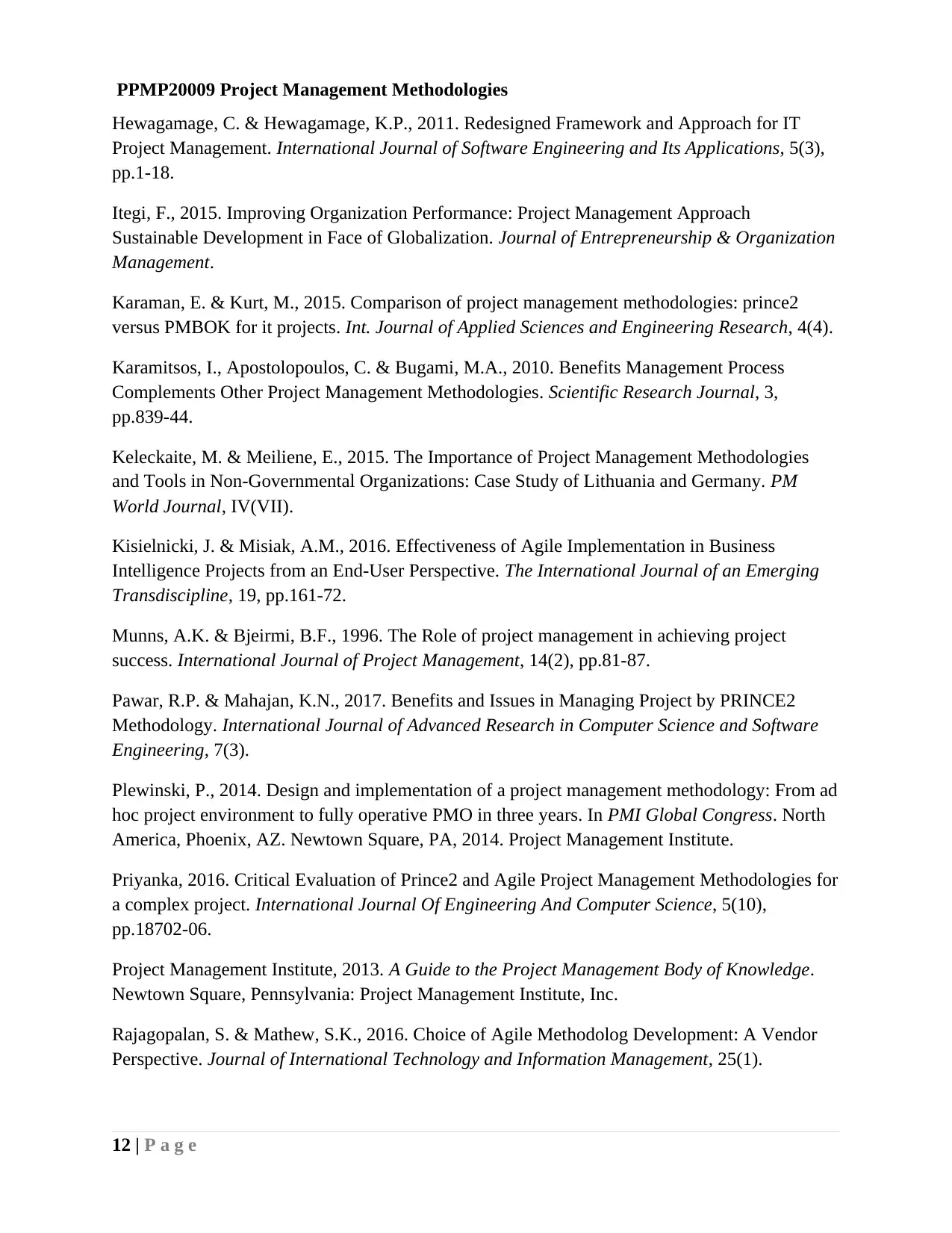
PPMP20009 Project Management Methodologies
Hewagamage, C. & Hewagamage, K.P., 2011. Redesigned Framework and Approach for IT
Project Management. International Journal of Software Engineering and Its Applications, 5(3),
pp.1-18.
Itegi, F., 2015. Improving Organization Performance: Project Management Approach
Sustainable Development in Face of Globalization. Journal of Entrepreneurship & Organization
Management.
Karaman, E. & Kurt, M., 2015. Comparison of project management methodologies: prince2
versus PMBOK for it projects. Int. Journal of Applied Sciences and Engineering Research, 4(4).
Karamitsos, I., Apostolopoulos, C. & Bugami, M.A., 2010. Benefits Management Process
Complements Other Project Management Methodologies. Scientific Research Journal, 3,
pp.839-44.
Keleckaite, M. & Meiliene, E., 2015. The Importance of Project Management Methodologies
and Tools in Non-Governmental Organizations: Case Study of Lithuania and Germany. PM
World Journal, IV(VII).
Kisielnicki, J. & Misiak, A.M., 2016. Effectiveness of Agile Implementation in Business
Intelligence Projects from an End-User Perspective. The International Journal of an Emerging
Transdiscipline, 19, pp.161-72.
Munns, A.K. & Bjeirmi, B.F., 1996. The Role of project management in achieving project
success. International Journal of Project Management, 14(2), pp.81-87.
Pawar, R.P. & Mahajan, K.N., 2017. Benefits and Issues in Managing Project by PRINCE2
Methodology. International Journal of Advanced Research in Computer Science and Software
Engineering, 7(3).
Plewinski, P., 2014. Design and implementation of a project management methodology: From ad
hoc project environment to fully operative PMO in three years. In PMI Global Congress. North
America, Phoenix, AZ. Newtown Square, PA, 2014. Project Management Institute.
Priyanka, 2016. Critical Evaluation of Prince2 and Agile Project Management Methodologies for
a complex project. International Journal Of Engineering And Computer Science, 5(10),
pp.18702-06.
Project Management Institute, 2013. A Guide to the Project Management Body of Knowledge.
Newtown Square, Pennsylvania: Project Management Institute, Inc.
Rajagopalan, S. & Mathew, S.K., 2016. Choice of Agile Methodolog Development: A Vendor
Perspective. Journal of International Technology and Information Management, 25(1).
12 | P a g e
Hewagamage, C. & Hewagamage, K.P., 2011. Redesigned Framework and Approach for IT
Project Management. International Journal of Software Engineering and Its Applications, 5(3),
pp.1-18.
Itegi, F., 2015. Improving Organization Performance: Project Management Approach
Sustainable Development in Face of Globalization. Journal of Entrepreneurship & Organization
Management.
Karaman, E. & Kurt, M., 2015. Comparison of project management methodologies: prince2
versus PMBOK for it projects. Int. Journal of Applied Sciences and Engineering Research, 4(4).
Karamitsos, I., Apostolopoulos, C. & Bugami, M.A., 2010. Benefits Management Process
Complements Other Project Management Methodologies. Scientific Research Journal, 3,
pp.839-44.
Keleckaite, M. & Meiliene, E., 2015. The Importance of Project Management Methodologies
and Tools in Non-Governmental Organizations: Case Study of Lithuania and Germany. PM
World Journal, IV(VII).
Kisielnicki, J. & Misiak, A.M., 2016. Effectiveness of Agile Implementation in Business
Intelligence Projects from an End-User Perspective. The International Journal of an Emerging
Transdiscipline, 19, pp.161-72.
Munns, A.K. & Bjeirmi, B.F., 1996. The Role of project management in achieving project
success. International Journal of Project Management, 14(2), pp.81-87.
Pawar, R.P. & Mahajan, K.N., 2017. Benefits and Issues in Managing Project by PRINCE2
Methodology. International Journal of Advanced Research in Computer Science and Software
Engineering, 7(3).
Plewinski, P., 2014. Design and implementation of a project management methodology: From ad
hoc project environment to fully operative PMO in three years. In PMI Global Congress. North
America, Phoenix, AZ. Newtown Square, PA, 2014. Project Management Institute.
Priyanka, 2016. Critical Evaluation of Prince2 and Agile Project Management Methodologies for
a complex project. International Journal Of Engineering And Computer Science, 5(10),
pp.18702-06.
Project Management Institute, 2013. A Guide to the Project Management Body of Knowledge.
Newtown Square, Pennsylvania: Project Management Institute, Inc.
Rajagopalan, S. & Mathew, S.K., 2016. Choice of Agile Methodolog Development: A Vendor
Perspective. Journal of International Technology and Information Management, 25(1).
12 | P a g e
⊘ This is a preview!⊘
Do you want full access?
Subscribe today to unlock all pages.

Trusted by 1+ million students worldwide
1 out of 18
Related Documents
Your All-in-One AI-Powered Toolkit for Academic Success.
+13062052269
info@desklib.com
Available 24*7 on WhatsApp / Email
![[object Object]](/_next/static/media/star-bottom.7253800d.svg)
Unlock your academic potential
Copyright © 2020–2025 A2Z Services. All Rights Reserved. Developed and managed by ZUCOL.
